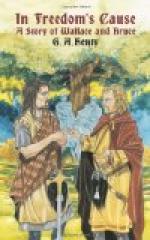The third English division now appeared; and the Scots, worn out by their long march and the two severe conflicts they had endured, were about to fly from the field when their leaders exhorted them to one more effort. The second batch of prisoners were slaughtered, and the pikemen again formed line to resist the English charge. Again were the cavalry defeated, Sir Robert Neville, their leader, slain, with many others, and the whole dispersed and scattered. Sir Robert Manton, who was the king’s treasurer, had had a quarrel with Fraser, when the latter was in Edward’s service, regarding his pay; and Fraser is said by some historians to have now revenged himself by slaying his prisoner. Other accounts, however, represent Manton as having escaped.
The slaughter of the prisoners appears, although cruel, to have been unavoidable; as the Scots, having before them a well appointed force fully equal to their own in number, could not have risked engaging, with so large a body of prisoners in their rear. None of the knights or other leaders were slain, these being subsequently exchanged or ransomed, as we afterwards find them fighting in the English ranks.
Seeing by this defeat that a vast effort was necessary to conquer Scotland, King Edward advanced in the spring of 1303 with an army of such numbers that the historians of the time content themselves with saying that “it was great beyond measure.” It consisted of English, Welsh, Irish, Gascons, and Savoyards. One division, under the Prince of Wales, advanced by the west coast; that of the king, by the east; and the two united at the Forth. Without meeting any serious resistance the great host marched north through Perth and Dundee to Brechin, where the castle, under the charge of Sir Thomas Maille, resisted for twenty days; and it was only after the death of the governor that it surrendered.
The English then marched north through Aberdeen, Banff, and Moray into Caithness, carrying utter destruction everywhere; towns and hamlets, villages and farmhouses were alike destroyed; crops were burned, forests and orchards cut down. Thus was the whole of Scotland wasted; and even the rich abbeys of Abberbredok and Dunfermline, the richest and most famous in Scotland, were destroyed, and the whole levelled to the ground. The very fields were as far as possible injured — the intention of Edward being, as Fordun says, to blot out the people, and to reduce the land to a condition of irrecoverable devastation, and thus to stamp out for ever any further resistance in Scotland.
During the three years which had elapsed since the departure of Wallace, Archie had for the most part remained quietly in his castle, occupying himself with the comfort and wellbeing of his vassals. He had, each time the English entered Scotland, taken the field with a portion of his retainers, in obedience to the summons of Comyn. The latter was little disposed to hold valid the grants made by Wallace,




